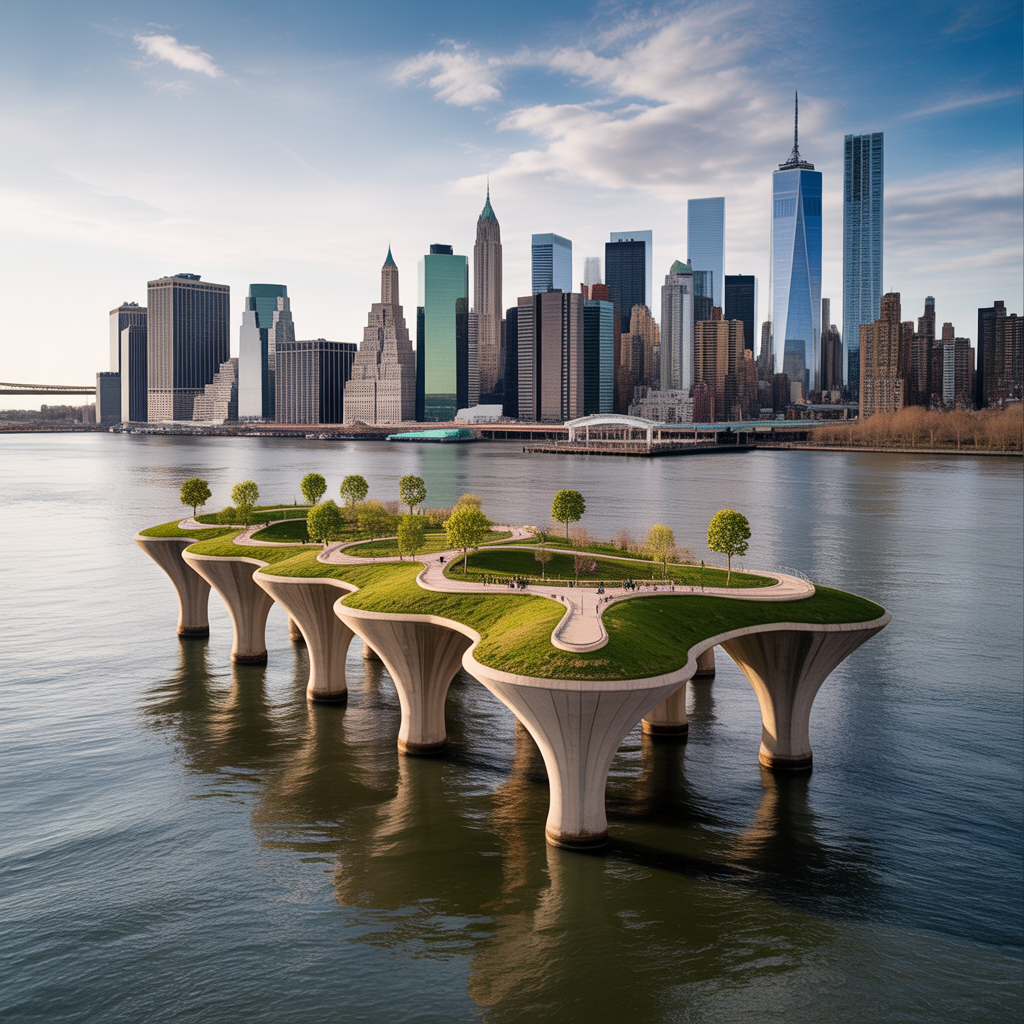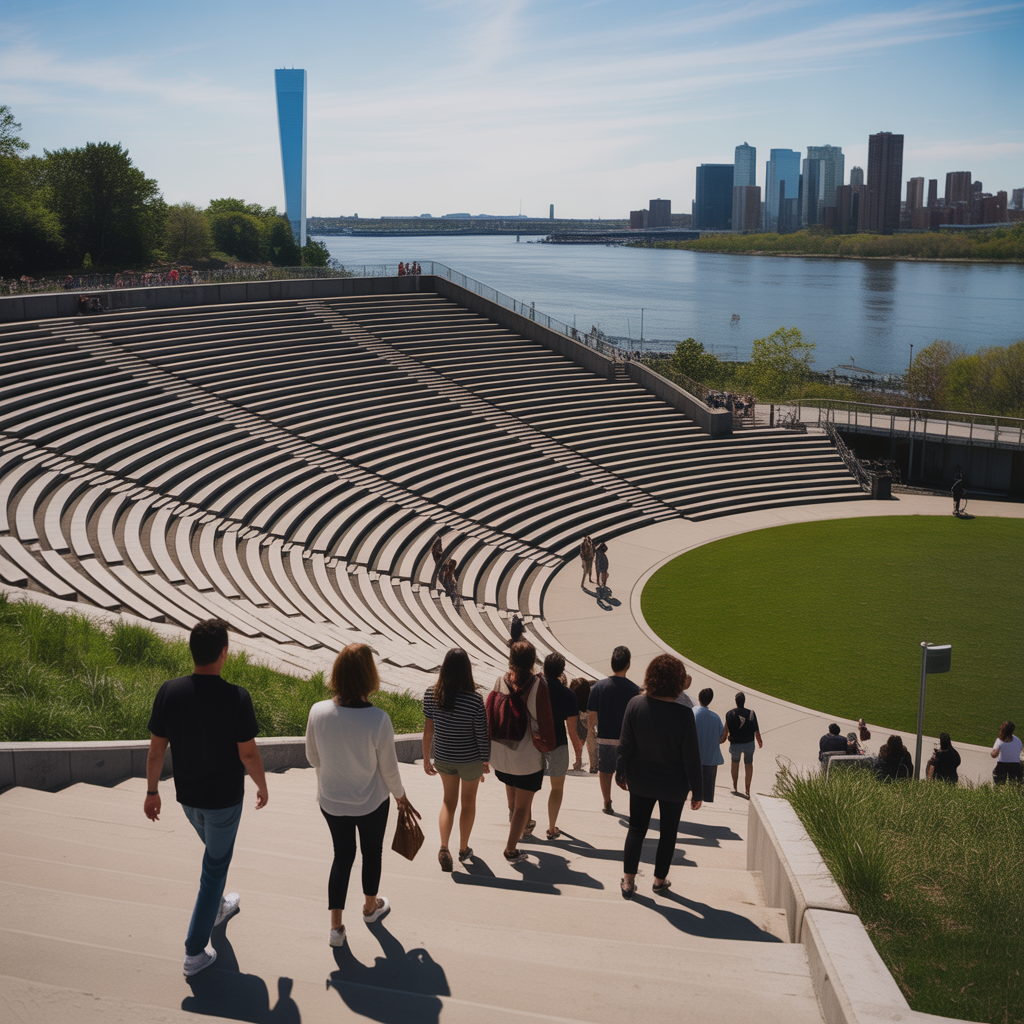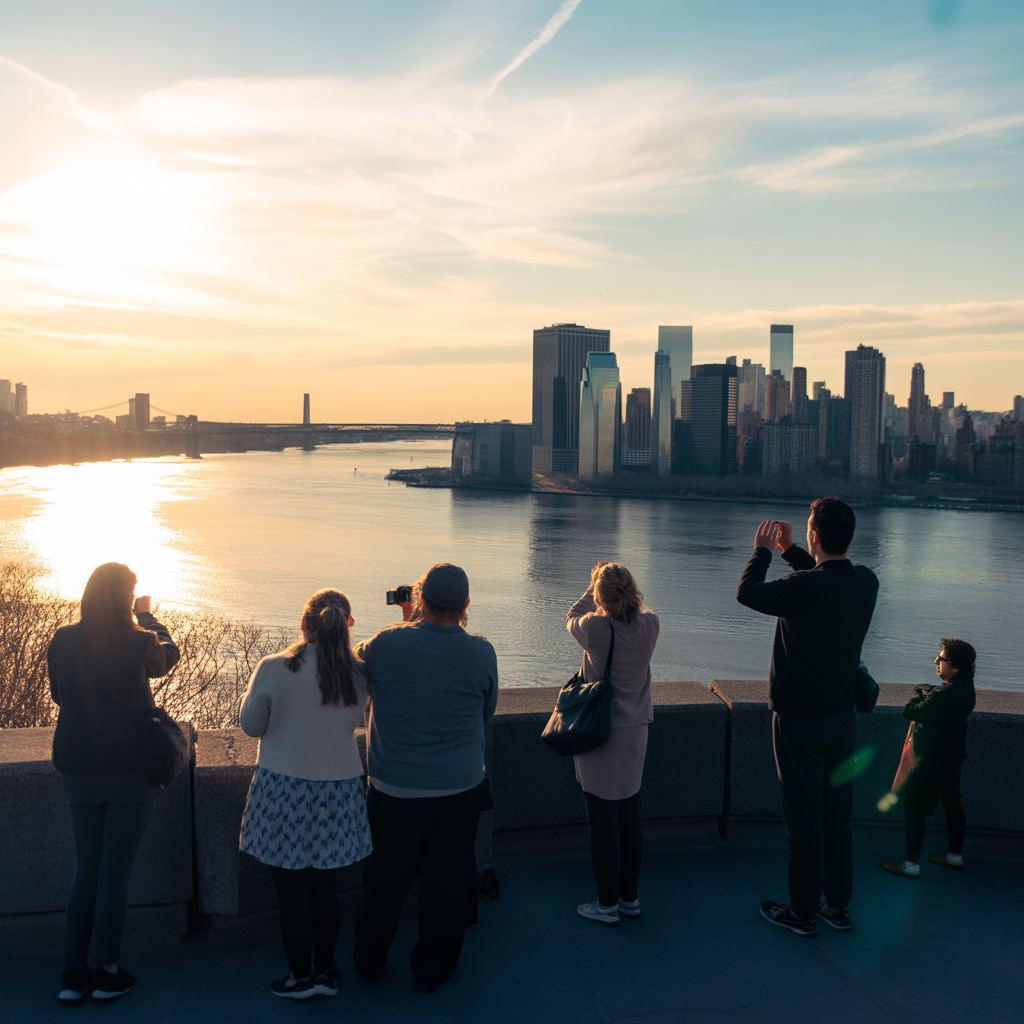Rising from the Hudson River like a verdant dream, Little Island represents one of New York City’s most ambitious and visually stunning public projects. This floating park, built on the site of the former Pier 55, has transformed a forgotten piece of waterfront into an extraordinary 2.4-acre oasis that seems to defy gravity itself. Since opening its doors to the public in May 2021, this architectural marvel has become a must-visit destination for both locals and tourists, offering a unique blend of nature, art, and breathtaking views in the heart of Manhattan’s Meatpacking District.
What is Little Island? A Vision Brought to Life
Little Island is the brainchild of media mogul Barry Diller, who gifted this $260 million masterpiece to New York City as a permanent public space. The park was designed by renowned British architect Thomas Heatherwick, whose innovative vision created what many consider to be one of the most unique public spaces in the world.
The park’s most striking feature is its foundation: 132 distinctive concrete “tulips” that rise from the Hudson River at varying heights, supporting the undulating landscape above. These sculptural supports create the illusion that the park is floating on water, giving Little Island its otherworldly appearance. The design allows for multiple microclimates and diverse planting areas, with each “tulip” supporting different elevations and creating a topography that ranges from intimate valleys to soaring hilltops.

What makes Little Island truly special is its commitment to being completely free and open to the public. Unlike many private developments, this space was designed specifically as a gift to the city, ensuring that everyone can experience its beauty regardless of their economic circumstances.
Location and How to Get There
Little Island is located at Pier 55, at the intersection of West 13th Street and the Hudson River in Manhattan’s trendy Meatpacking District. The park sits directly adjacent to the southern terminus of the High Line, making it an ideal companion destination for visitors exploring the area.
Getting to Little Island is convenient via multiple transportation options:
By Subway: The A, C, E, and L lines all provide easy access. Take the A, C, or E train to 14th Street-8th Avenue, then walk about 10 minutes west toward the Hudson River. Alternatively, take the L train to 8th Avenue-14th Street for a similar walk.
By Bus: Several bus lines serve the area, including the M11, M14, and M20, all of which stop within a few blocks of the park.
By Foot: The park is easily walkable from many Manhattan landmarks. It’s about a 15-minute walk from Union Square, 20 minutes from Chelsea Market, and just 5 minutes from the Whitney Museum.
Parking and Biking: Limited street parking is available in the surrounding area, though public transportation is highly recommended. Several Citi Bike stations are located nearby, including stations at West 13th Street & Hudson Street and at the Whitney Museum.
Attractions and Activities at Little Island
Despite its compact size, Little Island offers a remarkable variety of experiences and attractions that cater to different interests and age groups.
The Amfi: The park’s crown jewel is its 687-seat amphitheater, known as the Amfi. This outdoor performance venue hosts an impressive array of free programming throughout the warmer months, including concerts, dance performances, theater productions, and special events. The amphitheater’s design takes full advantage of the park’s unique topography, with audience seating that follows the natural curves of the landscape.
The Glade: For more intimate performances, the Glade offers a 200-seat venue nestled within the park’s rolling hills. This space is perfect for smaller concerts, poetry readings, and educational programs.
Scenic Overlooks: Multiple viewing areas throughout the park provide spectacular panoramic views of the Hudson River, New Jersey skyline, and the bustling waterfront. The varying elevations of the park create numerous vantage points, each offering a different perspective on the surrounding landscape.

Walking Paths and Gardens: Winding pathways lead visitors through carefully curated plantings that change with the seasons. The landscape design incorporates over 100 species of trees, shrubs, and perennials, creating a diverse ecosystem that supports local wildlife while providing year-round visual interest.
Art Installations: The park regularly features rotating art exhibitions and installations that complement its architectural beauty. These range from sculpture displays to interactive digital art experiences.
Planning Your Visit: Tickets and Timing
One of Little Island’s most appealing aspects is that admission is completely free. However, due to the park’s popularity and size limitations, visitors must reserve timed entry tickets in advance through the official website.
Ticket Reservation System: Tickets typically become available online several weeks in advance and can be reserved for specific time slots throughout the day. During peak seasons and weekends, tickets often sell out quickly, so advance planning is essential.
Best Times to Visit: The park is open year-round, but the experience varies significantly by season. Spring through fall offers the most comfortable weather and the fullest programming schedule. For the best experience, consider visiting during:
- Early morning (first entry slots) for peaceful exploration and great photography light
- Late afternoon leading into sunset for spectacular golden hour views
- Weekday visits to avoid the heaviest crowds
Weather Considerations: As an outdoor space, Little Island is subject to weather conditions. The park may close during severe weather, and visitors should dress appropriately for outdoor conditions. Summer visits require sun protection, while spring and fall visits may need layers for changing temperatures.
Making a Full Day: Nearby Attractions
Little Island’s location in the Meatpacking District makes it easy to combine with other popular attractions for a full day of exploration.
The High Line: Just steps away, this elevated park built on former railway tracks offers a completely different but equally fascinating perspective on urban green space. The two parks complement each other perfectly, and many visitors enjoy experiencing both in a single trip.
Whitney Museum of American Art: Located at the southern end of the High Line, the Whitney houses one of the world’s finest collections of contemporary American art. The museum’s location makes it a natural addition to any Little Island visit.
Chelsea Market: About a 10-minute walk north, this food hall and shopping destination occupies a full city block and offers dozens of dining options, from casual snacks to sit-down restaurants.
Meatpacking District Dining: The surrounding neighborhood has evolved into one of Manhattan’s premier dining destinations, with options ranging from upscale steakhouses to trendy rooftop bars with Hudson River views.
Events and Programming
Little Island’s programming is one of its most dynamic features, with a calendar that changes seasonally and includes both scheduled performances and special events.
Performance Schedule: The park typically runs its main programming season from late spring through early fall, with performances scheduled several times per week in both the Amfi and the Glade. These range from classical music concerts to contemporary dance performances, often featuring both established artists and emerging talent.
Educational Programs: The park offers various educational initiatives, including guided tours focused on architecture, sustainability, and urban ecology. These programs are particularly popular with school groups and families.
Special Events: Throughout the year, Little Island hosts special events including seasonal festivals, holiday celebrations, and community gatherings. These events often feature food vendors, additional entertainment, and extended hours.

Photography and Social Media Guide
Little Island is exceptionally photogenic, with countless opportunities for memorable photos and social media content.
Best Photo Spots: The park’s undulating topography creates numerous scenic viewpoints. Some of the most popular photography locations include the highest overlooks with river views, the architectural details of the “tulip” supports visible from various angles, and the intimate garden areas with seasonal plantings.
Golden Hour Magic: The park truly comes alive during golden hour, when the setting sun bathes the concrete structures and plantings in warm light. The western-facing orientation provides excellent sunset viewing opportunities.
Unique Angles: Consider capturing the park from multiple perspectives – the view from the High Line looking down, shots that emphasize the floating effect, and close-up details of the architectural elements and plant life.
Practical Information and Visitor Guidelines
Facilities: The park includes restroom facilities and is fully accessible to visitors with disabilities. All pathways are designed to accommodate wheelchairs and mobility devices.
What to Bring: Comfortable walking shoes are essential, as the park involves walking on varied terrain. Weather-appropriate clothing, sunscreen, and a camera are recommended. Water bottles are allowed, but outside food and beverages are generally prohibited.
Park Rules: To preserve the space for all visitors, the park has specific guidelines including no smoking, no alcohol (except during special permitted events), no pets (except service animals), and no large bags or backpacks.
Insider Tips for the Best Experience
To make the most of your Little Island visit, consider these expert recommendations:
Timing Strategy: Book tickets as soon as they become available, especially for weekend visits. Consider visiting on weekday mornings for the most peaceful experience.
Combined Visits: Plan your Little Island visit as part of a High Line walk, starting from either the northern or southern terminus and working your way to the park.
Seasonal Highlights: Each season offers different attractions – spring for blooming flowers, summer for full programming, fall for changing foliage, and winter for a more contemplative experience with smaller crowds.
Photography Planning: For the best photos, visit during the first or last time slots of the day when lighting is optimal and crowds are smaller.
The Future of Little Island
As Little Island continues to establish itself as a permanent fixture in New York’s cultural landscape, plans for expanding programming and developing new partnerships continue to evolve. The park’s management has expressed commitment to maintaining free public access while continuously enhancing the visitor experience through innovative programming and sustainable practices.
Future developments may include expanded educational programs, new art installations, and enhanced technology integration to improve the visitor experience while maintaining the park’s commitment to environmental sustainability and public accessibility.
Conclusion: A Must-Visit Manhattan Destination
Little Island represents more than just a park – it’s a testament to the power of visionary thinking and generous philanthropy to transform urban landscapes. Whether you’re a New York native looking for a new perspective on your city or a visitor seeking a unique experience, Little Island offers something truly special. The combination of innovative architecture, beautiful landscaping, world-class programming, and stunning views creates an experience that feels both grounding and transcendent.
From the moment you step onto this floating oasis, you’ll understand why Little Island has quickly become one of Manhattan’s most beloved destinations. Plan your visit today, reserve your tickets in advance, and prepare to be amazed by this remarkable addition to New York City’s incredible collection of public spaces. Whether you’re seeking artistic inspiration, natural beauty, or simply a peaceful respite from the bustling city, Little Island delivers an unforgettable experience that will leave you planning your next visit before you’ve even left.
